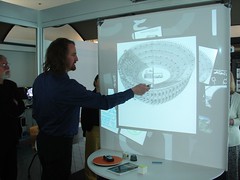David Macaulay is one of my favorite fine arts sources. Here's a Wikipedia bio:
David Macaualay (born December 2, 1946 in Lancashire, England) is an author and illustrator. He is an alumnus and faculty member at the Rhode Island School of Design.
Although originally from the UK, Macaulay moved to Bloomfield, New Jersey at the age of eleven. It was in the U.S. that he began drawing. After graduating from high school in Cumberland, Rhode Island in 1964, he enrolled in the Rhode Island School of Design (RISD), from which he received a bachelor's degree in architecture. He spent his fifth year at RISD in the European Honors Program, studying in Rome, Herculaneum and Pompeii.
Macaulay is the author of several books on architecture and design. His first book, Cathedral (1973), was a history, extensively illustrated with pen-and-ink drawings, of the construction of a fictitious but typical Gothic cathedral.
This was followed by a series of books of the same type: City (1974), on the construction of Verbonia, a fictitious but typical Roman city; Pyramid (1975), on the building of monuments to the Egyptian Pharaohs; Castle (1977), on the construction of Aberwyvern castle, a fictitious but typical Medieval Castle; Mill (1983), on the evolution of New England mills; and Mosque (2003).
Other books in this series are Underground (1976), which describes the building foundations and support structures (such as water and sewer pipes) that underlie a typical city intersection, and Unbuilding (1980), which describes the hypothetical dismantling of the Empire State Building in preparation for re-erection in Asia.
Macaulay has illustrated a number of other books, including the popular The Way Things Work (1988, text by Neil Ardley) which was expanded and re-released as The New Way Things Work (1998). These works remain his most commercially successful. He has also written a number of children's fiction books.
His books often display a whimsical humor. Illustrations in The Way Things Work depict cave people and woolly mammoths operating giant-sized versions of the devices he is explaining. Motel of the Mysteries, written in 1979 following the 1976-1979 exhibition of the Tutankhamun relics in the USA, concerns the discovery by future archaeologists of an American motel and the archaeologists' ingenious interpretation of the motel and its contents as a funerary and temple complex.
I'm looking forward to seeing you digest the video production of his marvelous work, Roman City. "All roads lead to Rome," for the next week.
Subscribe to:
Post Comments (Atom)





No comments:
Post a Comment